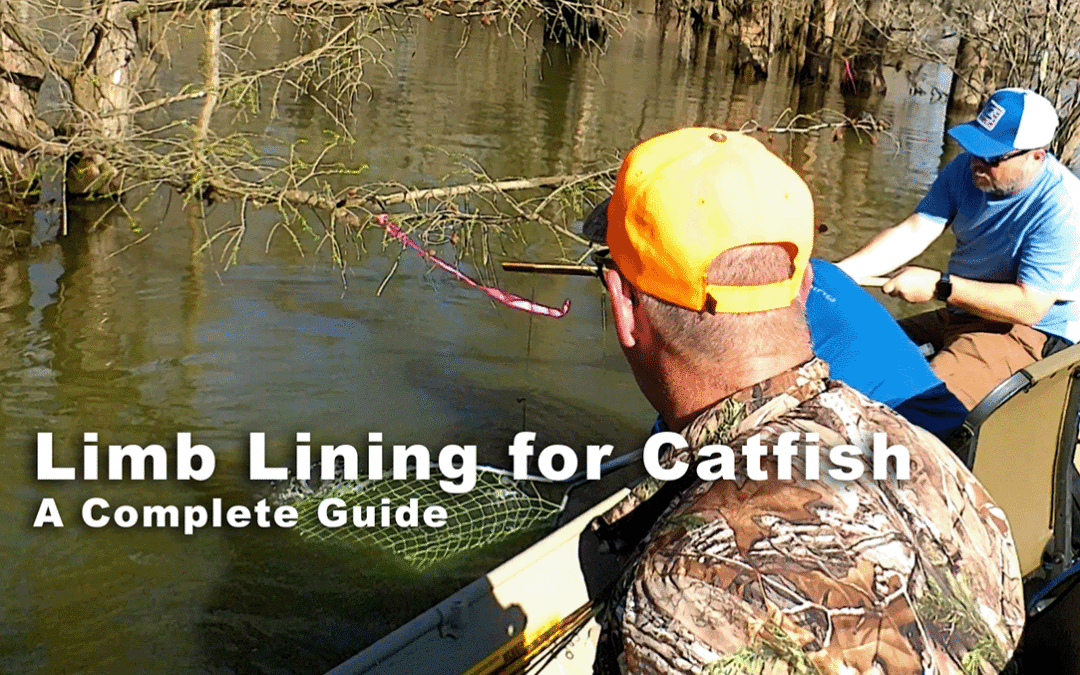What is Limb Lining?
Limb lining involves hanging baited hooks from tree branches that extend over water. The concept is beautifully simple: tie a strong line to a flexible branch, attach a hook and weight, add bait, and let nature do the rest. When a catfish takes the bait, the springy limb provides tension that helps set the hook and tire the fish.
A basic limb line setup consists of:
- Strong braided nylon trotline twine (#9 in green works well)
- Hooks (sizes 2/0 to 5/0 circle or J-hooks)
- Weights (½-ounce sliding egg weights work great)
- Bait
- Optional snap swivels if your line won’t fit through hook eyes
Selecting the Perfect Bait
The right bait can make all the difference when limb lining for catfish. Your bait choice should depend on your target catfish species and local conditions.
For Flathead Catfish:
Flatheads strongly prefer live bait. They’re predators that hunt live prey, so your best options include:
- Live bluegill (where legal)
- Live sunfish
- Live shad
- Live eels
For flatheads, rig your bait to swim near the surface without weight. The splashing and movement create vibrations that act like a dinner bell for these predatory cats.
For Blue and Channel Catfish:
These species are less picky and will readily take:
- Fresh cut bait (chunks of shad, herring, or other oily fish)
- Raw shrimp
- Hot dogs (a popular and convenient option)
- Chicken livers
- Catalpa worms (also called “catawba worms”)
Catalpa worms deserve special mention as they’re exceptional catfish bait, particularly for channel cats. These colorful caterpillars stay on the hook well and can often catch multiple fish per worm.
Setting Your Lines for Success
The location and method of setting your limb lines are crucial factors in your success rate.
Finding the Perfect Branch – What to
Look for:
- Supple, green limbs that have some flex
- Branches extending over deeper water
- Areas near creek channels, river bends, or drop-offs
- Isolated trees (they often produce better than trees in clusters)
Setting the Line:
- Cut your line to about 6 feet in length (or roughly your wingspan)
- Create a loop in one end for easy hanging and removal
- Run the other end through a weight
- Tie on your hook about 6 inches below the weight
- Hang the line by wrapping around the branch and passing the hook through the loop
Depth Considerations:
- For cut bait targeting blue or channel cats: 3-6 feet deep
- For live bait targeting flatheads: 10+ feet in deeper water
- Always keep bait suspended above any bottom snags
Seasonal Strategies
Catfish behavior changes throughout the year, so adjust your limb lining approach accordingly.
Spring:
- Focus on creek backs and gradually move toward main lake points
- Set lines on the first or second points heading into creeks
- Fresh shrimp and cut bait work exceptionally well
- This is prime time for limb lining as catfish become more active
Summer:
- Target deeper, cooler water during the day
- Look for bluff areas that transition into rock or mud banks
- Full moon periods are excellent for flathead catfish on limb lines
- Night fishing becomes more productive as water warms
Fall:
- Focus on channel edges and deeper holes
- Areas with current breaks hold more fish
- Cut bait becomes increasingly effective
Winter:
- Reduce the number of lines and focus on the deepest holes
- Slower metabolism means less feeding activity
- Cut bait often outperforms live bait in colder water
Legal Considerations
Before setting any limb lines, it’s essential to check your local fishing regulations. Rules vary significantly between states and even between different bodies of water within the same state.
Common regulations to check include:
- Number of hooks allowed per angler
- Whether lines must be labeled with your name and address
- Restrictions on certain bait types (using live bluegill is legal in South Carolina portions of the Waccamaw River but not in North Carolina)
- Required checking frequency (many areas require daily checks)
- Seasonal restrictions
- Size and creel limits for catfish
Tips for Success
Organization matters: Use a pool noodle to store your prepared limb lines. Simply hook each hook to the loop of the next line and wrap around the noodle to keep everything tangle-free.
Mark your locations: Use your boat’s electronics or a GPS to mark where you’ve set lines, especially if you’re setting multiple lines over a large area.
Conservation awareness: Consider releasing trophy-sized catfish. Many experienced limb liners catch plenty of 5-6 pound “eating-sized” cats but release the larger specimens to preserve the fishery.
Timing is everything: Set your lines about an hour before sundown and check them the following morning for best results.
Be prepared: Bring gloves, a net, and a cooler with ice if you plan to keep fish for the table.
Limb lining for catfish connects us to fishing traditions that predate modern tackle. There’s something profoundly satisfying about using this simple yet effective method to put fresh catfish on the table. Whether you’re targeting channel cats with cut bait or trophy flatheads with live offerings, the anticipation of checking those dancing limbs is an experience every catfish angler should enjoy.
Remember that the most successful limb liners are those who respect both the resource and the regulations designed to protect it. Check your local laws, release what you won’t use, and enjoy the timeless tradition of limb lining for catfish.
In conclusion:
Limb lining is a great way to put a lot of meat in the freezer. It’s also a lot of fun! Kids love it! It makes for an easy day of eating snacks, riding in the boat, and the thrill of seeing the limb bounce and the fish splash as they fight the line to land the catfish. If you enjoy eating catfish limb lining might be your next fishing adventure!

